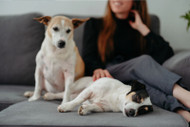Stress in Dogs: Signs, Prevention and Relief Techniques
Posted by Virbac Vet -
Just like humans, dogs can get stressed or anxious. However, since they can’t tell us that something’s troubling them, it’s up to us to spot the signs of anxiety in dogs and step in to help. In this guide we’ll explain what can cause stress in dogs, how to read the signs, and how to calm a stressed dog.
Recognising the signs of a stressed dog
Dogs get stressed when they’re feeling anxious, scared, threatened, frustrated, uncertain, or bored. Possible causes of stress in dogs are:
- Unfamiliar people, places or animals
- Loud noises
- Unpredictable behaviour
- Changes to routine
- Change of environment
- Transportation
- Lack of exercise or mental stimulation
- Illness or pain
- Separation anxiety
An anxious or stressed dog might display some of the following behaviours whilst they are exposed to the stressor or unsure of a situation:
- Lower or tuck their tail
- Narrow or widen their eyes
- Pin their ears back
- Shake
- Pant
- Lick their lips
- Yawn
- Pace back and forth
- Whine, yelp or howl
- Be easily startled
- Chew or destroy items
- Have stomach upsets or lack of appetite
- Urinate or defecate inappropriately
If there is prolonged or repeated exposure to a stressor this can present in different ways or you might notice your dog has changed how it copes in certain situations. Typical signs that your dog might be stressed include:
- Change in demeanour
- Difficulty to train
- Chewing at their paws
- Soiling in inappropriate places
- Destructive behaviours
- Excessive vocalisation
- Gastrointestinal symptoms such as diarrhea
- Aggression
If your dog is extremely stressed and scared, they may become aggressive and show these signs:
- Tense and freeze their whole body
- Put their weight on the front paws
- Hold the tail high
- Lunge
- Growl or snarl
- Bare their teeth
- Give a warning snap or even bite
Dogs often display the more subtle signs of stress long before they resort to aggressive behaviours, but it is really important to recognise the signs to avoid any escalation of behaviours keeping your dog and everyone around them safe. It can also help you avoid stressors in the future, preventing them from turning into established fears.
Getting to the root of your dog’s stress
If your dog suddenly appears stressed, consider what was happening in their environment beforehand. Are you visiting an unfamiliar place? Did a specific person enter the room? Did something startle the dog?
If there was no obvious trigger in the moments before, consider what might have changed in your dog’s life in the days or weeks prior. Have you gone back to the office after a break? Is your dog going on fewer walks than usual? Is there a new pet or baby in the home?
Understanding separation anxiety
Separation anxiety happens when a dog is emotionally dependent on their caregiver and gets very distressed by their absence or when left alone. Your dog might show signs of this by being excessively clingy while you’re putting on your shoes, urinate in the house while you’re gone, display destructive behaviours whilst being left and vocalisation.
In addition to the calming tips we’ll discuss below, you can help your dog to manage separation anxiety by:
- Teaching them to spend time independently e.g. short periods in a crate or another room while you’re home. Work to create a positive association with the crate by providing enrichment activities and build up the amount of time your dog is left.
- Leave enrichment toys such as snuffle mats and puzzle games or freeze their favourite treat on a lick mat.
- Playing or walking before leaving to burn off anxious energy
- Leaving an item of clothing with your scent
- Using a calming product formulated for dogs
- Leaving the radio or TV on
- Talk to a behaviourist about specific advice on how to tackle the separation anxiety, an individualised approach is often required.
Preventing stress in dogs
Socialisation - Exposing your dog to lots of different people, animals and experiences from a young age will get them familiar with socialising and give them the confidence to adapt to new scenarios.
Routine - Like us, dogs find comfort in familiarity and consistency. Make sure your dog can relax safely in the knowledge that their food, walks and favourite people are never far away.
Positive reinforcement - Punishment doesn’t work when training dogs. In fact, it’s a common source of stress. Instead, ignore undesirable behaviours and only give attention, treats and other positive reinforcements to your dog when they’re displaying the goal behaviour.
How to calm a stressed dog
Keep yourself calm - Your dog is sensitive to changes in your mood! Raising your voice, rushing to their side, or telling them off can actually escalate stress behaviour. To avoid this, always stay calm when dealing with a stressed dog.
Create a soothing environment - Set aside a quiet, comfortable area of your home just for your dog, complete with cosy bedding and favourite toys. Make sure they have free access and encourage other family members not to disturb them.
Remove stressors - Remove the stressor or take your dog from the stressful environment and let them regroup in a quiet place. If you are able to do, distract your dog with enrichment activities.
Get them moving - Physical activity can be a great stress reliever. Take your stressed dog out for a walk or provide some mental stimulation in the house with puzzle feeder games, snuffle mats and lick mats. Sniffing can be a great game to help calm a dog, a simple game of ‘find it’ can be very rewarding for all dogs and can be something you can do at home.
Try relaxation techniques - Touch can help your dog to relax. If they allow you, stroke or brush your dog with gentle, consistent movements, while talking to them in a steady and reassuring tone. However, if they show any signs of escalating stress, it’s best to back off and give them space instead.
Use calming remedies - If your dog is stressed or anxious, you may consider a pheromone solution. They can come as diffusers or spray to put around the home, releasing natural pheromones that have a calming effect on dogs. Pheromones are odourless chemical substances used for communication between individuals of the same species. Artificial pheromones mimic this natural calming effect, making your dog feel safe and secure. They come in a range of products designed for different uses, such as sprays, collars, and diffusers
Stress can lead to long-term anxiety and health issues for both humans and dogs. Learning to recognise the signs of anxiety in dogs means you can quickly help your canine companion feel more relaxed and happy. If you’re struggling to figure out what’s troubling your dog or how to manage the stress be sure to speak to your vet or a behavioural specialist for support.


